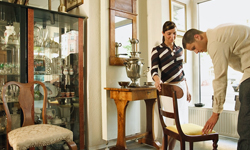Introduction
Antique and delicate furniture pieces can add an exquisite touch to any home decor. These valuable items hold historical, cultural, and artistic significance, making their preservation a priority for collectors and enthusiasts alike. However, due to their age and fragile nature, these pieces require special care and attention to ensure their longevity. In this blog post, we will discuss various preservation techniques that can help you maintain the beauty and integrity of your antique and delicate furniture.
1. Cleaning and Dusting
When it comes to preserving antique and delicate furniture, regular cleaning and dusting play a crucial role. Dust can accumulate on the surface and in crevices, which may lead to scratches and damage over time. To clean your antique furniture, use a soft, lint-free cloth or a feather duster. Gently wipe the surface and intricate details, making sure to reach all the corners and nooks. Avoid using harsh chemicals or abrasive cleaners, as they can harm the delicate finish.
1.1 Cleaning Techniques
To remove stubborn dirt or stains, dampen the cloth slightly with a mixture of mild soap and warm water. Wring out excess moisture to prevent water damage. Carefully wipe the affected area in a gentle, circular motion. Afterward, use a dry cloth to remove any leftover moisture. When dealing with delicate surfaces like veneer or marquetry, it is essential to be extra cautious and avoid excessive moisture.
2. Avoid Direct Sunlight
Exposure to direct sunlight can cause irreversible damage to antique furniture. The UV rays can fade or darken the wood, causing discoloration. To protect your furniture, position it away from windows or use curtains and blinds to shield it from direct sunlight. If possible, rotate the furniture periodically to ensure even exposure to light.
2.1 Use UV Filters
In instances where it is challenging to control sunlight exposure, consider using UV filters. These transparent films can be applied to windows or glass cabinets to block harmful UV rays. UV filters can significantly reduce the risk of fading and help preserve the original beauty of your antique furniture.
3. Humidity Control
Antique furniture is susceptible to damage caused by fluctuations in humidity levels. High humidity can cause wood to warp, while low humidity can lead to cracking or splitting. To maintain an optimal level of humidity, consider using a humidifier or dehumidifier in your home. Aim for a relative humidity level between 40% and 55% to ensure the longevity of your antique furniture.
3.1 Monitor Humidity Levels
Invest in a hygrometer to monitor the humidity levels in your home. This device will provide you with accurate readings, enabling you to take appropriate action if the levels become too high or too low. Additionally, avoid placing antique furniture near heat sources or in damp areas, as this can exacerbate moisture-related issues.
4. Preventive Measures
Prevention is key when it comes to caring for antique and delicate furniture. By taking a few extra precautions, you can significantly minimize the risk of damage and preserve the original condition of your cherished pieces.
4.1 Protective Covers
Consider using protective covers, especially during periods of extended non-use or when moving furniture. These covers create a barrier against dust, pests, and accidental scratches. Opt for breathable materials like cotton or linen to prevent moisture buildup.
4.2 Furniture Pads and Felt
Applying furniture pads or felt to the bottom of your antique pieces can prevent scratches and damage caused by everyday use. These pads also help to distribute the weight evenly, reducing the risk of warping or stress on the joints.
5. Professional Restoration
For valuable and severely damaged antique furniture, professional restoration may be necessary. Restorers can repair structural issues, replace missing parts, and revive the original finish. However, it is crucial to choose a reputable and experienced restorer who specializes in antique furniture restoration.
Summary
Preserving antique and delicate furniture is crucial to safeguard their historical and artistic value. This blog post will provide insights into essential preservation techniques that can help you protect these valuable pieces. By following proper see this here cleaning, storage, and handling methods, you can ensure the longevity of your antique furniture while enjoying their beauty in your living space.

Welcome to my website! My name is Tyson Boreham, and I am a professional Indoor Air Quality Specialist with a passion for creating clean and healthy living environments. With years of experience in the field, I have dedicated my career to helping individuals and families improve the air quality in their homes. Read More

